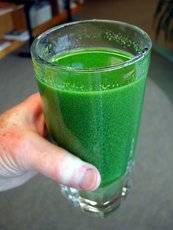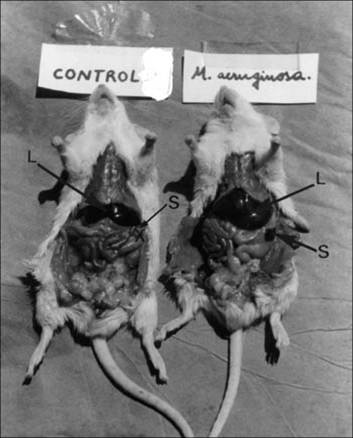Microcystis: Difference between revisions
imported>Yera Patel |
imported>Yera Patel |
||
| Line 53: | Line 53: | ||
== Other Effects on the Body from Exposure == | == Other Effects on the Body from Exposure == | ||
'''Acute Exposure''' | ===='''Acute Exposure'''==== | ||
- nausea, vomiting, and diarrhea. | - nausea, vomiting, and diarrhea. | ||
'''Eye Exposure''' | '''Eye Exposure''' | ||
Revision as of 21:47, 15 April 2008
Articles that lack this notice, including many Eduzendium ones, welcome your collaboration! |
 | ||||||||||||||
| Scientific classification | ||||||||||||||
| ||||||||||||||
| Binomial name | ||||||||||||||
| Microcystis Aeruginosa |
What is Microcystis?
Microcystis Aeruginosa is a type of harmful blue-green algae which is also referred to as cyanobacteria. They say that the walls of the bacteria are stained gram positive but the cells appear gram negative. This species is colonial, which means that single cells can join together in groups as colonies which tend to float near the water surface. Colony sizes will vary from a few to hundreds of cells. It is a common bloom-forming algae found primarily in nutrient enriched fresh waters and lower salinity estuaries. Microcystis aeruginosa is one of more than 700 species of algae that may be found in water samples collected and usually blooms in mid to late summer.
Genomic Structure
The colony is held together by mucilage and consists of thousands of individual cells, which are about 2-3 µm in size.
Appearance
Microcystis becomes very noticeable during bloom events. Thick mats of the algae can coat the water so heavily that you cannot see your hand an inch below the surface. In calm, fresh water areas, it may look like someone spilled green paint on the surface. On closer inspection, the mats can be seen to be comprised of small flakes or balls. If the algae is blown by the wind or pushed by currents into higher salinity waters where it cannot survive, it generally takes on a greenish-yellow color and a chunky appearance as it dies.
Causes of Blooming
Microcystis blooms are more frequently associated with warm, fresh, nutrient enriched water. Blooms generally occur in mid to late summer and can carry on into the fall. Excess nutrients (particularly phosphate) that are added to the Bays by human activities may contribute to the frequency and intensity of blooms.
History
Annual late summer blooms of Microcystis are frequently observed in the tidal freshwater portions of the Potomac River. During the 1970’s and early 1980’s, this area of the Potomac River experienced large blooms. Since the early 1980’s blooms have occurred to varying degrees in both the Potomac and Upper Bay. Larger than normal blooms occurred in the upper Chesapeake Bay and it’s tributaries during August and September 2000.
Time Frame of Blooming
Since algae benefit from warm, sunny weather, as the days get shorter and cooler, the algae are likely to dissipate. Any toxins that are in the water will decline as the algae die off. In addition, any rainfall will help to circulate the water and break up the bloom.
Health Concerns
Microcystis is different from most other types of algae because it secretes a toxin into the water. During an algae bloom, the amount of toxin in the water can become elevated and exposure can be potentially harmful to people and animals.
Algae can remove oxygen through normal respiration at night or through the decomposition process as the bloom dies. In such situation, there may not be enough oxygen remaining in the water to support fish or shellfish in the vicinity. Furthermore, as these large blooms die and sin to the bottom, they commonly release chemicals that can produce a foul odor and musty taste.
Some strains of Microcystis may produce toxins that have been reported to result in health problems to animals that drink the water, and minor skin irritation and gastrointestinal discomfort in humans that come in contact with toxin blooms.
Other Effects on the Body from Exposure
Acute Exposure
- nausea, vomiting, and diarrhea.
Eye Exposure
- irritation, pain, swelling, photophobia, conjunctivitis, visual differences
High Exposure
- Temperature high fever, even hypothermia (in animals)
All other Exposure Effects
- Earaches, Swollen lips, Sore Throat, Abdominal Pain, Loss of Appetite,
In animals it can cause Swelling of the organs.
Two Mice were used in an experiment to show the effects of M.Aeurginosa on the Organs in their bodies the results showed significant changes.
Concerns Related to the Exposure to Toxins of Microcystis
Health concerns vary depending on the type of exposure, if its contact or ingestion and the concentrations of microcystis and its toxin, known as microcystin. Contact with high levels of the cyanobacteria algae has been found to contribute to eye, ear and skin irritation. More serious health effects, for example muscle craps, twitching, can also occur. If elevated levels of the algal toxin, microcystin, are also present in the water, serious liver damage can result.
Most Recent Research
Toxin Algae Return to Lake Erie
A research study was being done in 1999, where researchers were examining whether microcystis was the reason why zebra mussels were coming back to the waters after being introduced to lake Erie it in 1986 from Russia.
Microcystis Discovered in Jacksonville,FL
Study showed a Large Bloom was occurring in the water of the St. John's River, it was shown that more and more toxins were being pulled out of the water with more testing. Along with this the bacteria that they had found was indeed microcystis.


